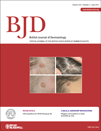-
Views
-
Cite
Cite
D.R. Berk, Effectiveness of conventional, low‐dose and intermittent oral isotretinoin in the treatment of acne: a randomized, controlled comparative study: comment, British Journal of Dermatology, Volume 165, Issue 1, 1 July 2011, Page 205, https://doi.org/10.1111/j.1365-2133.2011.10305.x
Close - Share Icon Share
Extract
Funding sources: None.
Conflicts of interest: None declared.
Madam, I read with great interest the article by Lee et al.1 entitled ‘Effectiveness of conventional, low‐dose and intermittent oral isotretinoin in the treatment of acne: a randomized, controlled comparative study’. Low‐dose and intermittent‐dose isotretinoin regimens for acne have recently received considerable attention because of the intriguing potential they offer of comparable efficacy with fewer and less severe side‐effects, as well as decreased costs.2 This is especially true for moderate acne, as studied by Lee et al. I applaud Lee et al. for their ambitious and important attempt to compare conventional and nonconventional isotretinoin doses in a prospective, randomized, open trial with blinded assessment. However, I would like very respectfully to note several aspects of their study which make me question their conclusions. First, the ‘conventional’ regimen used in their study is, in my opinion, not very conventional. In their trial, Lee et al. defined the ‘conventional’ dose as 0·5–0·7 mg kg−1 daily for 24 weeks, which would theoretically result in cumulative doses of 84–118 mg kg−1. Indeed, the mean ± SD cumulative dose for the ‘conventional’ dose group was 90·0 ± 16·7 mg kg−1. However, as noted throughout the rest of their paper, conventional regimens should instead reach cumulative doses of 120 mg kg−1. Therefore, in order to avoid skewing efficacy data in favour of nonconventional regimens, a true and fair comparison study of the effectiveness of conventional and other dosing regimens should include a conventional regimen which actually reaches a cumulative dose of 120 mg kg−1. Moreover, it should be noted that some authors have suggested extending the duration of low‐dose regimens beyond the 4–6 months of conventional dose regimens, e.g. for 8–9 months, to allow greater total dose accumulation and decrease relapses.3, 4 In addition, in their study, Lee et al. defined relapse as ‘deterioration to moderate or more severe based on the GAGS global score’. When such strict definitions of relapse are used, studies may not capture milder relapses which are still clinically significant. Unfortunately, in the literature there is no standard definition for relapse in clinical studies of isotretinoin for acne. Of course, the relapse rate will vary greatly depending on how narrowly relapse is defined,5 and the definition of relapse may be a critical factor in the conclusions drawn from comparative studies like that of Lee et al. For example, relapse may instead be much more broadly defined as ‘receiving an anti‐acne medicine’.5 Usage of the latter definition of relapse may allow researchers better to capture significant differences between conventional and low‐dose or intermittent‐dose isotretinoin regimens. Finally, while Lee et al. acknowledge that their study was limited by their small sample size, an additional important limitation is the relatively short duration (1 year) of post‐treatment follow‐up. Greater follow‐up, e.g. for a total of 2 or 3 years, as used elsewhere,6 is likely to uncover additional relapses and better capture any differences in the effectiveness of the conventional and nonconventional doses.





